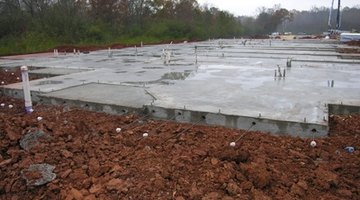How to Estimate the Cost of a Concrete Slab
A concrete slab may be used as a base for a patio or shed, or may simply be used to finish a basement floor. No matter what you're using it for, the basic construction of the slab is the same in most residential applications.

By understanding how the slab is built from start to finish, you can create an estimate for this work based on material prices in your area.
Tip
If you are having trouble getting prices, or the prices you've gotten seem too high, consult the McGraw Hill guide, "Estimating Construction Costs." This book is updated annually and contains unit prices for materials and labor for every possible construction trade. It is broken down by region or state, making for more accurate pricing. This guide is widely used in the construction field by estimators who need a quick price range to compare bids or prepare an estimate. Most libraries have a copy of this book in their reference section.
Warning
Never excavate without first determining the location of underground utilities. In most areas, a public utility marking company will do this work for you, though some may charge a nominal fee. If you are unsure where your power, cable, phone, Internet, and water/sewer/gas lines are on your property, consult your local utility marking company to ask about fees for this service. Be sure to include these fees in your estimate.
-
Decide on the size of your concrete slab. You'll need to know the length and width so that you are able to calculate square footage of materials needed.
-
Calculate the amount of concrete you will need. Concrete is sold in cubic yards (27 square feet), so you will need to multiply your square footage from Step 1 by the depth of slab, then divide by 27. For example, a 10-foot-by-10-foot slab would require 1.3 yards of concrete. This is equal to [(10x10x.33 feet)/27]. The average concrete slab is 4 inches deep, but if you need more for your particular application, just calculate the depth you plan to use. Make sure to translate the thickness of the slab from inches to feet before using the equation above.
-
Contact local concrete distributors and ask for a price based on the amount you'll need. Add about 10 percent to the cubic yard figure you determined in Step 2, as some material will be lost during pouring and transport from the truck.
-
Ask the concrete companies about costs for delivery as well as overtime fees. These amounts are not typically included in the cubic yard pricing. Overtime fees are especially relevant, because concrete trucks work on extremely tight schedules. The operators expect you to be ready and waiting for them when they arrive, with easy access and no waiting around. They can and do begin charging overage fees if you delay the process in any way, and these fees can be significant.
-
Figure in the cost of excavation. A concrete slab is generally installed over a gravel base. The base is 4 inches, and the slab itself is 4 inches, with 2 inches above ground and 2 inches below. This means that for the average slab, you will be digging down 6 inches. If you are planning a particularly large or thick slab, you may need to consider renting a small excavator to help with this work. You can get rental prices from a local home improvement store or equipment yard.
-
Include the cost of gravel. For a 4-inch slab, you'll need the same amount of gravel you calculated for concrete, as the gravel bed will also be 4 inches deep. Use the same calculation to arrive at cubic yards of gravel, then multiply by 1.5 tons per cubic yard to get the number of tons you will need. You can get a price per ton on gravel from a local home improvement store or quarry. Also include enough plastic vapor barrier to cover the gravel layer. This material is sold in rolls, and the cost is fairly negligible.
-
Add in the cost of tools if you don't already own them. You'll need a shovel, wheelbarrow, hoe or rake, trowels and four two-by-fours to frame the edges of the slab. Because wet concrete can irritate the skin, you may also want to invest in some heavy-duty rubber gloves and/or boots.
The Drip Cap
- A concrete slab may be used as a base for a patio or shed, or may simply be used to finish a basement floor.
- By understanding how the slab is built from start to finish, you can create an estimate for this work based on material prices in your area.
- Decide on the size of your concrete slab.
- These amounts are not typically included in the cubic yard pricing.
- Figure in the cost of excavation.
- A concrete slab is generally installed over a gravel base.
- For a 4-inch slab, you'll need the same amount of gravel you calculated for concrete, as the gravel bed will also be 4 inches deep.
References
Writer Bio
Emily Beach works in the commercial construction industry in Maryland. She received her LEED accreditation from the U.S. Green Building Council in 2008 and is in the process of working towards an Architectural Hardware Consultant certification from the Door and Hardware Institute. She received a bachelor's degree in economics and management from Goucher College in Towson, Maryland.
Photo Credits
- fresh concrete image by jimcox40 from Fotolia.com
- fresh concrete image by jimcox40 from Fotolia.com
More Articles



